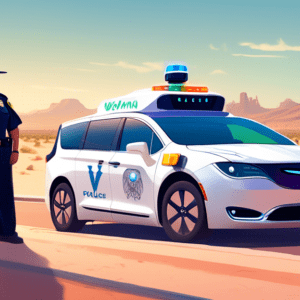Incident Raises Questions About the Technology’s Readiness for Public Roads
In a concerning incident that has sent ripples through the autonomous vehicle industry, a Waymo robotaxi was recently pulled over by law enforcement in Phoenix, Arizona, for driving the wrong way down a one-way street. The incident, captured on video by a bystander, has reignited the debate about the safety and reliability of self-driving technology.
Details of the Incident
According to reports, the Waymo robotaxi, a Jaguar I-Pace equipped with the company’s self-driving system, was operating in autonomous mode with a safety driver behind the wheel. As the vehicle approached a clearly marked one-way street, it inexplicably turned onto the road, driving against the flow of traffic. Fortunately, the safety driver was able to intervene promptly, bringing the vehicle to a stop before any collision occurred. Police officers arrived at the scene and issued a warning to the safety driver.
Waymo’s Response and Investigation
Waymo has acknowledged the incident and issued a statement emphasizing their commitment to safety. The company is currently conducting a thorough investigation to determine the root cause of the error. Preliminary findings suggest that the vehicle’s perception system may have misidentified the one-way signage, leading to the incorrect maneuver. Waymo has stated that they are working to improve their system’s ability to accurately interpret road markings and signage.
Implications for the Autonomous Vehicle Industry
This incident has raised concerns about the readiness of self-driving technology for widespread deployment. While Waymo and other companies have logged millions of miles in autonomous mode, incidents like this highlight the challenges and complexities of navigating real-world driving environments. The incident also underscores the crucial role of safety drivers in these early stages of autonomous vehicle development.
The Importance of Robust Testing and Regulation
The incident has reignited calls for rigorous testing and regulation of autonomous vehicles. Experts emphasize the need for comprehensive safety protocols, including robust testing in diverse conditions, before self-driving cars can be considered truly safe for public roads. Additionally, there are ongoing discussions about the need for clear regulations and liability frameworks to address incidents involving autonomous vehicles.
Public Perception and Trust
Incidents like this have the potential to erode public trust in autonomous vehicle technology. Building and maintaining public confidence is crucial for the widespread adoption of self-driving cars. Companies like Waymo will need to work diligently to address safety concerns and demonstrate the reliability of their technology.
The Future of Waymo and Robotaxis
Despite this setback, Waymo remains a leader in the autonomous vehicle industry. The company has a strong track record of innovation and safety, and it is likely to learn from this incident and further refine its technology. However, the incident serves as a reminder that the development and deployment of self-driving cars is a complex and ongoing process. It is essential for companies to prioritize safety, transparency, and public trust as they continue to advance this transformative technology.
The Role of Human Drivers in an Autonomous Future
As the investigation into the Waymo incident continues, it also highlights the crucial role human drivers still play in the transition to an autonomous future. While self-driving technology holds immense promise, incidents like this demonstrate the importance of human oversight and intervention. Safety drivers serve as a vital safeguard, able to react to unexpected situations and prevent accidents.
Moreover, this incident emphasizes the need for ongoing education and training for human drivers sharing the road with autonomous vehicles. As self-driving cars become more prevalent, understanding their capabilities and limitations will be paramount for ensuring safe interactions on our roads.
Conclusion: A Call for Continued Vigilance
The recent incident involving a Waymo robotaxi driving the wrong way serves as a stark reminder of the complexities of autonomous driving and the importance of continued vigilance. While self-driving technology holds immense potential for enhancing safety and efficiency on our roads, incidents like this highlight the need for rigorous testing, transparent investigation, and ongoing collaboration between industry stakeholders, regulators, and the public. As we navigate the transition to an autonomous future, it is imperative that safety remains paramount, and that we learn from both the successes and setbacks along the way.
